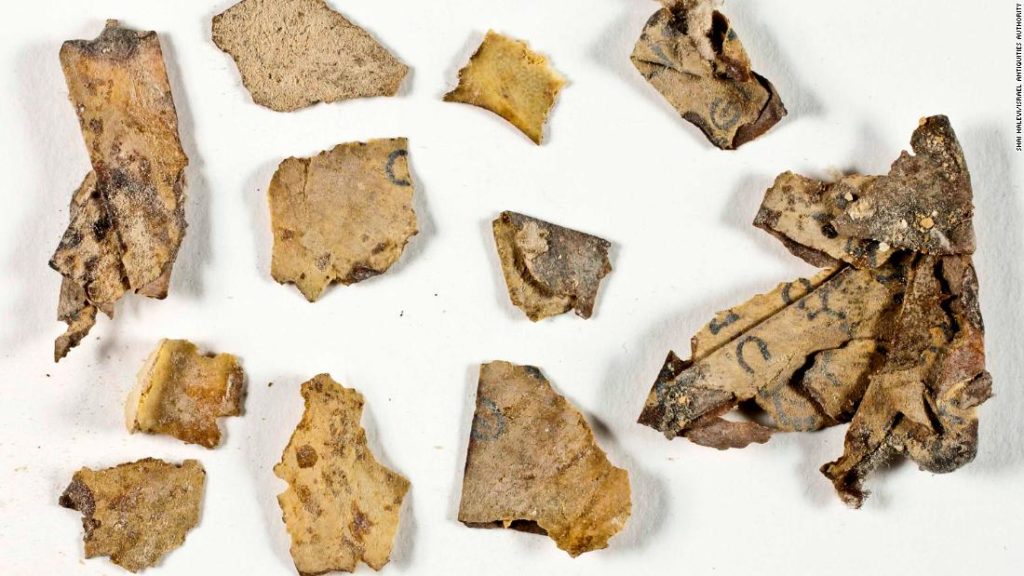The scroll fragments bear verses from the books of the prophets Zechariah and Nahum. The scrolls were written in Greek.
Archaeologists have been working in the caves and cliffs of the Judean Desert since 2017 as part of a “national operation aimed at preventing looting of antiquities,” according to the press release.

The basket pictured here is thought to be the oldest complete example in the world. Credit: Yaniv Berman/Israel Antiquities Authority
Teams also found a 6,000-year-old skeleton of a child, rare coins, and a complete basket believed to be the oldest in the world, dating back 10,500 years.
Discovered 70 years ago in caves around Qumran, the Dead Sea Scrolls are among archaeology’s most significant scriptural finds, containing the oldest versions of the Hebrew Bible and other Jewish texts that date to the time of Jesus. Most of the scrolls are kept at the Shrine of the Book, part of the Israel Museum in Jerusalem.

Archaeologists also found these rare coins. Credit: Ofer Sion/Israel Antiquities Authority
The latest scroll fragments were found in the Cave of Horror, which is around 80 meters (262 feet) below a cliff top in the Judean Desert. It can only be reached by abseiling from the top.
Since the Dead Sea Scrolls were discovered more than 70 years ago, the area has attracted attention from looters, according to the press release. Climatic conditions in the area mean scrolls and ancient documents are exceptionally well preserved.
“The aim of this national initiative is to rescue these rare and important heritage assets from the robbers’ clutches,” said Israel Hasson, director of Israel’s Antiquities Authority, who called for more resources to complete the recovery operation.

The site is known as the Cave of Horror. Credit: Eitan Klein/Israel Antiquities Authority
“We must ensure that we recover all the data that has not yet been discovered in the caves, before the robbers do. Some things are beyond value.”
Hananya Hizmi, head staff officer of the Archaeology Department of the Civil Administration in the West Bank, said this was “an exciting moment” and the results of the operation shed more light on the history of the region.
“The finds attest to a rich, diverse and complex way of life, as well as to the harsh climatic conditions that prevailed in the region hundreds and thousands of years ago,” said Hizmi.
Since October 2017, teams have surveyed 80 kilometers (49.7 miles) of desert caves, many of which are virtually inaccessible, according to the press release.
Eleven lines of text have been reconstructed, including parts of a Greek translation of Zechariah 8:16-17. On another fragment verses from Nahum 1:5-6 were identified.

Archaeologists had to abseil into the Cave of Horror. Credit: Eitan Klein/Israel Antiquities Authority
Archaeologists also discovered the partially mummified skeleton of a 6-12-year-old child, buried in a shallow pit beneath two flat stones and wrapped in cloth, which dates back 6,000 years.
“It was obvious that whoever buried the child had wrapped him up and pushed the edges of the cloth beneath him, just as a parent covers his child in a blanket,” said Ronit Lupu, an archaeologist at the Israel Antiquities Authority.
“The child’s skeleton and the cloth wrapping were remarkably well preserved and because of the climatic conditions in the cave, a process of natural mummification had taken place; the skin, tendons, and even the hair were partially preserved, despite the passage of time.”
Centuries of a hot and dry climate mean that the large basket, with a capacity of 90-100 liters and made from plant material, can provide new insight on how products were stored around 1,000 years before the invention of pottery, said the press release.
You may also like
-
Afghanistan: Civilian casualties hit record high amid US withdrawal, UN says
-
How Taiwan is trying to defend against a cyber ‘World War III’
-
Pandemic travel news this week: Quarantine escapes and airplane disguises
-
Why would anyone trust Brexit Britain again?
-
Black fungus: A second crisis is killing survivors of India’s worst Covid wave

